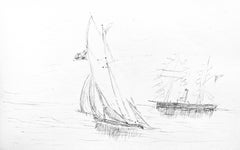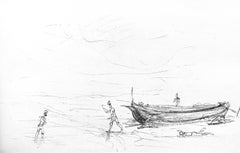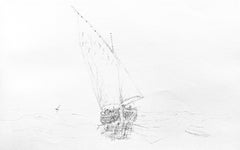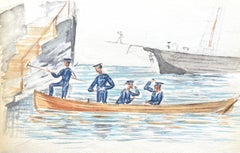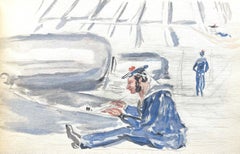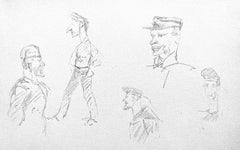Post-Impressionist Figurative Prints
In the revolutionary wake of Impressionism, artists like Vincent van Gogh, Georges Seurat, Paul Cézanne and Paul Gauguin advanced the style further while firmly rejecting its limitations. Although the artists now associated with Postimpressionist art did not work as part of a group, they collectively employed an approach to expressing moments in time that was even more abstract than that of the Impressionists, and they shared an interest in moving away from naturalistic depictions to more subjective uses of vivid colors and light in their paintings.
The eighth and final Impressionist exhibition was held in Paris in 1886, and Postimpressionism — also spelled Post-Impressionism — is usually dated between then and 1905. The term “Postimpressionism” was coined by British curator and art critic Roger Fry in 1910 at the “Manet and the Postimpressionists” exhibition in London that connected their practices to the pioneering modernist art of Édouard Manet. Many Postimpressionist artists — most of whom lived in France — utilized thickly applied, vibrant pigments that emphasized the brushstrokes on the canvas.
The Postimpressionist movement’s iconic works of art include van Gogh’s The Starry Night (1889) and Seurat’s A Sunday on La Grande Jatte (1884). Seurat’s approach reflected the experimental spirit of Postimpressionism, as he used Pointillist dots of color that were mixed by the eye of the viewer rather than the hand of the artist. Van Gogh, meanwhile, often based his paintings on observation, yet instilled them with an emotional and personal perspective in which colors and forms did not mirror reality. Alongside Mary Cassatt, Cézanne, Henri Matisse and Gauguin, the Dutch painter was a pupil of Camille Pissarro, the groundbreaking Impressionist artist who boldly organized the first independent painting exhibitions in late-19th-century Paris.
The boundary-expanding work of the Postimpressionist painters, which focused on real-life subject matter and featured a prioritization of geometric forms, would inspire the Nabis, German Expressionism, Cubism and other modern art movements to continue to explore abstraction and challenge expectations for art.
Find a collection of original Postimpressionist paintings, mixed media, prints and other art on 1stDibs.
1950s Post-Impressionist Figurative Prints
Lithograph
1950s Post-Impressionist Figurative Prints
Lithograph
1950s Post-Impressionist Figurative Prints
Lithograph
1950s Post-Impressionist Figurative Prints
Lithograph
1950s Post-Impressionist Figurative Prints
Lithograph
1950s Post-Impressionist Figurative Prints
Lithograph
1950s Post-Impressionist Figurative Prints
Lithograph
1940s Post-Impressionist Figurative Prints
Lithograph
1890s Post-Impressionist Figurative Prints
Lithograph
Early 20th Century Post-Impressionist Figurative Prints
Lithograph
Early 20th Century Post-Impressionist Figurative Prints
Lithograph
1920s Post-Impressionist Figurative Prints
Lithograph
Early 20th Century Post-Impressionist Figurative Prints
Lithograph
Early 20th Century Post-Impressionist Figurative Prints
Lithograph
Early 20th Century Post-Impressionist Figurative Prints
Lithograph
Early 20th Century Post-Impressionist Figurative Prints
Lithograph
Early 20th Century Post-Impressionist Figurative Prints
Lithograph
1890s Post-Impressionist Figurative Prints
Paper, Woodcut
1890s Post-Impressionist Figurative Prints
Color Pencil, Lithograph
1910s Post-Impressionist Figurative Prints
Etching
1890s Post-Impressionist Figurative Prints
Lithograph
1890s Post-Impressionist Figurative Prints
Lithograph
1890s Post-Impressionist Figurative Prints
Lithograph
1930s Post-Impressionist Figurative Prints
Lithograph
1910s Post-Impressionist Figurative Prints
Etching
1930s Post-Impressionist Figurative Prints
Lithograph
1950s Post-Impressionist Figurative Prints
Paper, Monotype
20th Century Post-Impressionist Figurative Prints
Lithograph
19th Century Post-Impressionist Figurative Prints
Stencil
1890s Post-Impressionist Figurative Prints
Etching
1950s Post-Impressionist Figurative Prints
Lithograph
1950s Post-Impressionist Figurative Prints
Etching
1910s Post-Impressionist Figurative Prints
Woodcut
21st Century and Contemporary Post-Impressionist Figurative Prints
Pastel
1920s Post-Impressionist Figurative Prints
Etching
21st Century and Contemporary Post-Impressionist Figurative Prints
Screen
1920s Post-Impressionist Figurative Prints
Etching
1990s Post-Impressionist Figurative Prints
Etching
20th Century Post-Impressionist Figurative Prints
Woodcut
1950s Post-Impressionist Figurative Prints
Woodcut
1920s Post-Impressionist Figurative Prints
Lithograph
Early 1900s Post-Impressionist Figurative Prints
Lithograph
